
Jordan...
Stats...
Overview:
For most of its history since independence from British administration in
1946, Jordan was ruled by King HUSSEIN (1953-99). A pragmatic ruler, he
successfully navigated competing pressures from the major powers (US,
USSR, and UK), various Arab states, Israel, and a large internal Palestinian
population, despite several wars and coup attempts. In 1989 he reinstituted
parliamentary elections and gradual political liberalization; in 1994 he signed a
formal peace treaty with Israel. King ABDALLAH II - the eldest son of King
HUSSEIN and Princess MUNA - assumed the throne following his father's
death in February 1999. Since then, he has consolidated his power and
undertaken an aggressive economic reform program. Jordan acceded to the
World Trade Organization in 2000, and began to participate in the European
Free Trade Association in 2001. After a two-year delay, parliamentary and
municipal elections took place in the summer of 2003. The Prime Minister
and government appointed in April 2005 declared they would build upon the
previous government's achievements to respect political and human rights and
improve living standards.
Population: 5,759,732
Location:
Middle East, northwest of Saudi Arabia
Map references:
Middle East
Area:
Total Area: 92,300 sq km
Land Area: 91,971 sq km
Comparative Area: slightly smaller than Indiana
Capital:
Amman
National holiday:
Independence Day, 25 May (1946)
More Jordan Facts...
More Tips on Travelling to the Middle East...
Overview:
For most of its history since independence from British administration in
1946, Jordan was ruled by King HUSSEIN (1953-99). A pragmatic ruler, he
successfully navigated competing pressures from the major powers (US,
USSR, and UK), various Arab states, Israel, and a large internal Palestinian
population, despite several wars and coup attempts. In 1989 he reinstituted
parliamentary elections and gradual political liberalization; in 1994 he signed a
formal peace treaty with Israel. King ABDALLAH II - the eldest son of King
HUSSEIN and Princess MUNA - assumed the throne following his father's
death in February 1999. Since then, he has consolidated his power and
undertaken an aggressive economic reform program. Jordan acceded to the
World Trade Organization in 2000, and began to participate in the European
Free Trade Association in 2001. After a two-year delay, parliamentary and
municipal elections took place in the summer of 2003. The Prime Minister
and government appointed in April 2005 declared they would build upon the
previous government's achievements to respect political and human rights and
improve living standards.
Population: 5,759,732
Location:
Middle East, northwest of Saudi Arabia
Map references:
Middle East
Area:
Total Area: 92,300 sq km
Land Area: 91,971 sq km
Comparative Area: slightly smaller than Indiana
Capital:
Amman
National holiday:
Independence Day, 25 May (1946)
More Jordan Facts...
More Tips on Travelling to the Middle East...